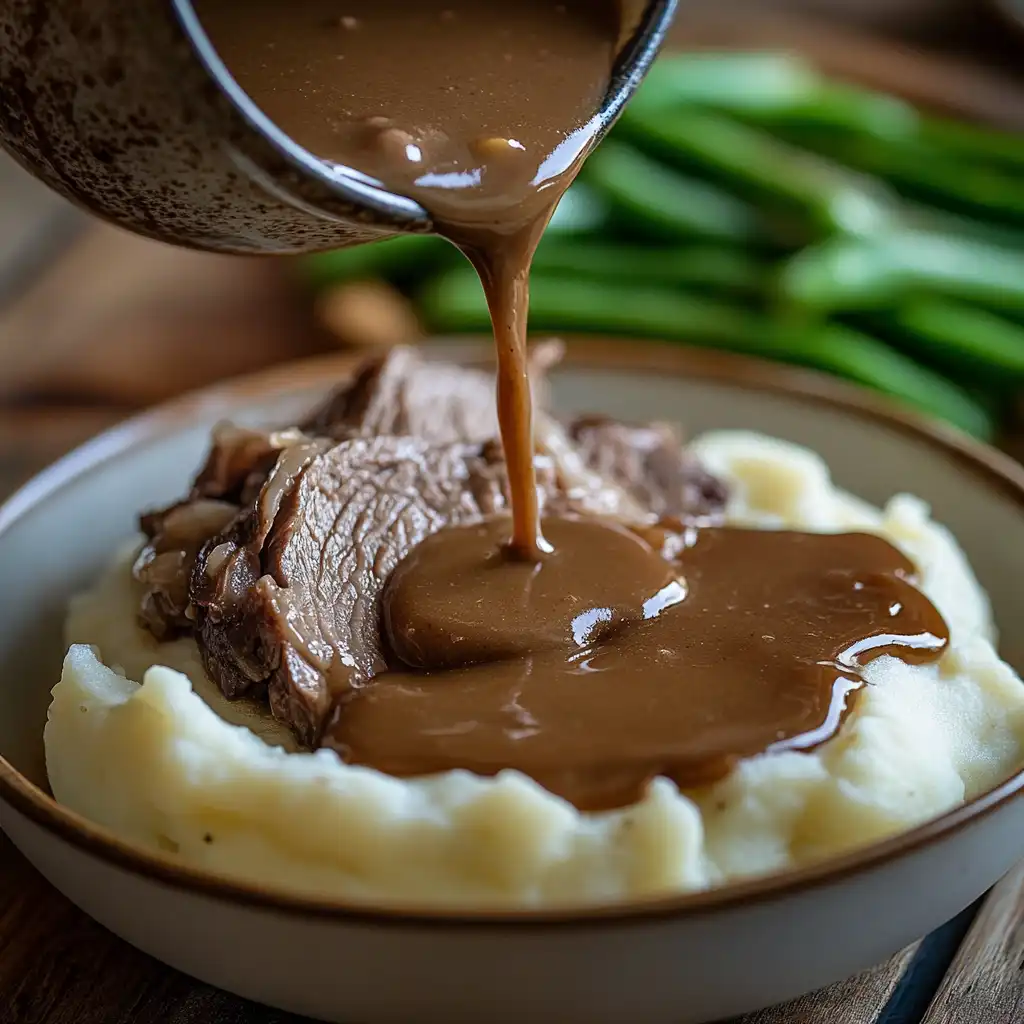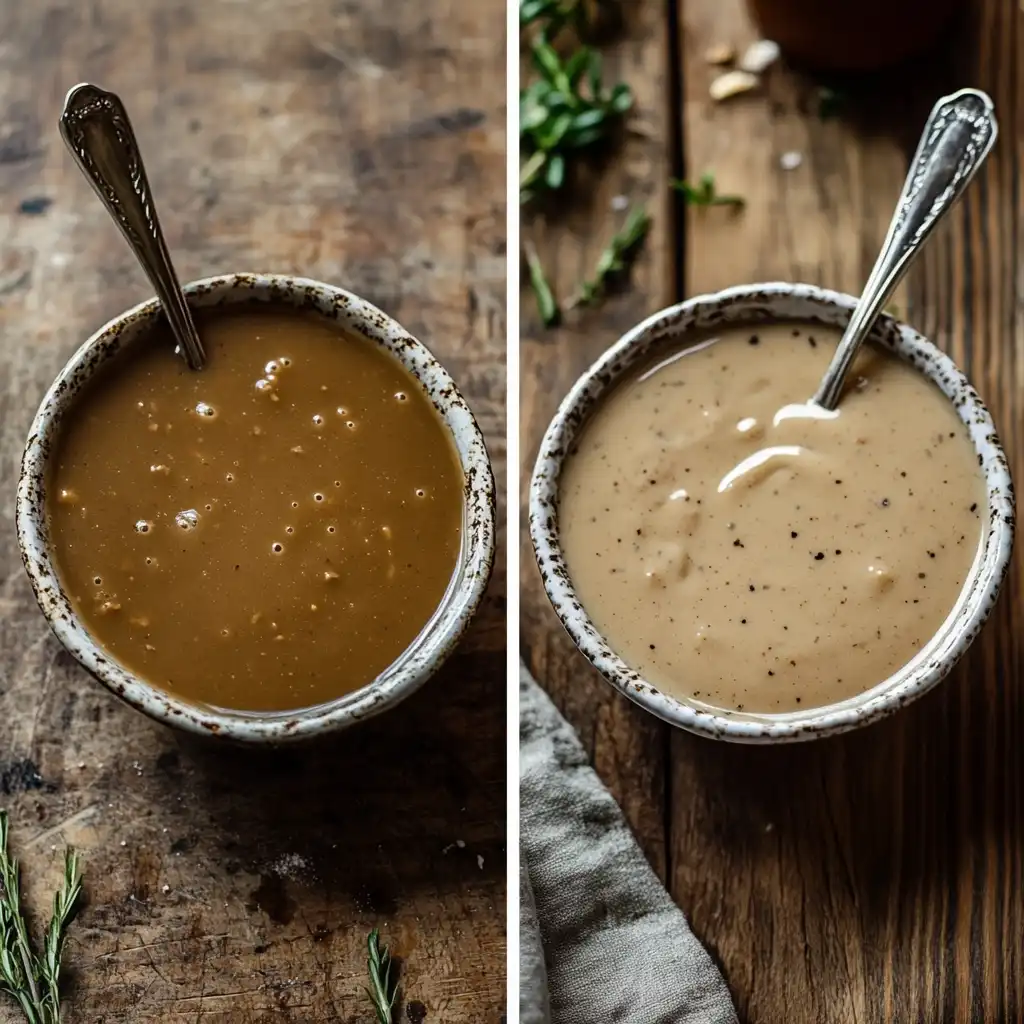
Beef gravy is a favorite in many dishes, but the debate over cornstarch vs. flour for gravy often arises. Each option offers unique benefits in flavor and texture. By understanding their differences, you can choose the perfect thickener to suit your preferences and recipes.
Table of Contents
The Role of Thickening Agents in Gravy
Thickening agents transform thin liquids into smooth, velvety gravies. When comparing cornstarch vs. flour for gravy, both achieve this through a process called gelatinization, but they differ in their impact on the gravy’s consistency and appearance.
Cornstarch vs. Flour: A Quick Comparison
The debate over cornstarch vs. flour for gravy comes down to personal preferences in flavor, texture, and cooking methods. Cornstarch offers a glossy finish and gluten-free option, while flour delivers a creamy texture and richer taste.
Texture, Taste, and Appearance
The choice between cornstarch and flour impacts the texture, taste, and appearance of the gravy:
- Cornstarch: Known for its strong thickening power, cornstarch produces a clear, glossy gravy with a smooth, silky texture. It thickens quickly and is ideal for dishes where transparency and a lighter mouthfeel are preferred. However, overusing cornstarch can result in a gelatinous texture.
- Flour: Flour creates a more opaque and creamy gravy, contributing a slightly nutty and hearty flavor. It is less potent as a thickener compared to cornstarch and requires longer cooking to remove its raw taste. Flour-based gravies tend to have a richer, heavier feel, which pairs well with traditional comfort foods.
Nutritional Comparisons
The nutritional profiles of cornstarch and flour also differ, making them suitable for different dietary preferences:
- Cornstarch: Cornstarch is gluten-free, making it a popular choice for individuals with gluten sensitivities or celiac disease. It contains fewer calories and carbohydrates than flour, but it lacks significant amounts of protein or fiber.
- Flour: All-purpose flour contains gluten and is richer in protein and dietary fiber compared to cornstarch. While it provides more nutrients, it is not suitable for those with gluten intolerance.
Understanding these differences helps cooks tailor their choice of thickening agents to suit their gravy’s flavor profile, desired texture, and the dietary needs of their guests.
To improve the flow and coherence of the content, here’s the revised version with a higher percentage of transition words included:

Benefits of Using Cornstarch
In the debate over cornstarch vs. flour for gravy, cornstarch thickens liquids quickly and easily, producing glossy gravies that work well with modern recipes. It’s also an excellent choice for gluten-free diets
Ease of Use and Fast Thickening
Cornstarch is not only easy to use but also works quickly. Unlike flour, it thickens liquids in a short amount of time, which makes it especially useful for last-minute preparations. Therefore, it’s an excellent choice for busy cooks.
Gluten-Free Option
In addition to its ease of use, cornstarch is naturally gluten-free. This makes it ideal for individuals with gluten intolerance or celiac disease. As a result, you can create delicious gravies that cater to a wider range of dietary needs.
Producing Glossy Gravies
Gravies made with cornstarch have a clear and glossy appearance. Consequently, they enhance the visual appeal of your dishes. Furthermore, the smooth and silky texture works perfectly for light, elegant sauces that elevate the dining experience.
Benefits of Using Flour
In the comparison of cornstarch vs. flour for gravy, flour adds depth and richness to gravies, making it the traditional choice for hearty, comfort foods like pot roasts or casseroles. It also reheats well.
Traditional Thickening Method
Flour has been a staple in traditional gravy recipes for centuries. For this reason, it remains a favorite among many home cooks. Moreover, it provides a sense of authenticity and nostalgia that is hard to replicate with other thickening agents.
Adds Richness and Depth
In contrast to cornstarch, flour adds a rich, nutty flavor to gravies. This not only deepens the taste but also complements hearty dishes such as mashed potatoes or roasted meats. Consequently, it’s an excellent choice for comfort food.
Consistency for Reheating and Freezing
Unlike cornstarch, flour-based gravies maintain their consistency over time. For example, they do not break down or become watery when reheated or frozen. As a result, they are perfect for meal prepping or saving leftovers, ensuring your dishes remain just as delicious later.
This updated version uses transition words like therefore, consequently, furthermore, and moreover to improve connectivity and coherence between ideas.
Flavor Profiles: Which Tastes Better?
Impact of Cornstarch on Gravy Flavor
Cornstarch has a neutral taste, which means it does not alter the flavor of the gravy significantly. This allows the natural flavors of the beef stock and seasonings to shine. However, because it lacks any distinct taste, it may not add depth or richness to the gravy. For those who prefer a lighter and more delicate flavor profile, cornstarch is an excellent choice.
Flour’s Contribution to the Flavor Profile
Flour, on the other hand, has a subtle, nutty flavor that enhances the overall taste of the gravy. When cooked properly, it contributes a warm, hearty undertone that pairs well with traditional comfort foods. Additionally, the browning process during roux preparation can add a slight caramelized note, which brings depth and complexity to the gravy’s flavor.
Texture and Appearance Differences
Glossy and Translucent Finish with Cornstarch
Gravies thickened with cornstarch have a smooth, glossy, and translucent appearance. This polished finish makes them visually appealing and is particularly suited for refined presentations. The texture is light and silky, offering a modern, elegant feel to dishes.
Creamy and Opaque Texture with Flour
In contrast, flour creates a creamy and opaque texture in gravy. This results in a more rustic and hearty appearance, which is ideal for classic comfort foods. The thickness provided by flour is slightly heavier, delivering a rich and satisfying mouthfeel that works well with traditional roasts or casseroles.
Cooking Techniques for Cornstarch-Based Gravy
Mixing Cornstarch with Cold Water
To prevent clumping, cornstarch must be mixed with cold water before being added to the hot liquid. This creates a smooth slurry that blends seamlessly into the gravy. Stirring continuously while adding the slurry ensures even thickening and prevents lumps.
How to Prevent Lumps in Cornstarch Gravy
Cornstarch gravy requires constant stirring during cooking to avoid lumps. It is essential to add the slurry slowly while the liquid is at a gentle simmer. Overheating or rapid boiling should also be avoided, as excessive heat can break down the cornstarch, leading to a thinner consistency. Proper technique ensures a smooth, lump-free gravy every time.
This version highlights the flavor, texture, and preparation methods for cornstarch and flour-based gravies, ensuring clarity and flow.
Cooking Techniques for Flour-Based Gravy
Creating a Roux for Flour-Based Gravy
A key technique in making flour-based gravy is creating a roux. To do this, equal parts of flour and fat (such as butter or drippings) are cooked together over medium heat. The roux should be stirred continuously until it reaches the desired color—light for a subtle flavor or darker for a nuttier, richer taste. Once the roux is ready, the liquid (broth or stock) is added gradually while whisking to ensure a smooth consistency.

Adjusting Thickness Gradually
When using flour as a thickener, it’s important to adjust the thickness gradually. Start by adding small amounts of liquid to the roux, whisking thoroughly after each addition to prevent lumps. As the gravy thickens, more liquid can be incorporated until the desired consistency is achieved. This step-by-step approach allows better control over the texture and prevents the gravy from becoming too thick or runny.
Which Option is Healthier?
Caloric Differences Between Cornstarch and Flour
Cornstarch and flour differ in their caloric content. Cornstarch has fewer calories per tablespoon compared to flour, making it a slightly lighter option. For those monitoring their calorie intake, choosing cornstarch could be beneficial in reducing overall calories in the dish.
Nutritional Pros and Cons
While cornstarch is lower in calories, it lacks significant nutritional value. It is almost pure carbohydrate with little protein, fiber, or micronutrients. On the other hand, flour, particularly whole wheat flour, contains more protein and dietary fiber. These nutrients can contribute to satiety and offer additional health benefits. However, flour also contains gluten, which may not be suitable for individuals with gluten sensitivities or celiac disease.
In summary, the choice between cornstarch and flour depends on dietary preferences and needs. Cornstarch suits those seeking a low-calorie or gluten-free option, while flour provides added nutrients and a richer flavor profile.
For lighter, healthier gravy recipes, consider exploring Rice Cakes: Benefits and Recipes for Healthy Snacking.
Best Use Cases: When to Choose Cornstarch or Flour
Cornstarch for Quick Meals and Glossy Finishes
Cornstarch is ideal for dishes that need to be prepared quickly. Its fast thickening properties save time in the kitchen, making it perfect for last-minute meals. Additionally, cornstarch creates a glossy finish, which works well for gravies meant to enhance the visual appeal of refined dishes like roasted meats or vegetables.
Flour for Hearty Dishes and Traditional Recipes
Flour is the better choice for gravies in hearty, comfort foods such as pot roasts, casseroles, or mashed potatoes. Its creamy, opaque texture and rich flavor complement these traditional dishes perfectly. Flour-based gravies are also more stable for reheating and freezing, making them a reliable choice for meal prepping or leftovers.
Common Mistakes When Making Gravy
Overusing Cornstarch or Flour
One common mistake is using too much thickening agent. Overusing cornstarch can result in a gravy that is overly gelatinous and unappetizing. Similarly, too much flour can make the gravy overly heavy and lead to a pasty texture. To avoid this, always measure the thickening agent carefully and adjust gradually to achieve the desired consistency.
Not Properly Cooking the Thickening Agent
Failing to cook the thickening agent correctly can ruin the flavor and texture of the gravy. Cornstarch needs to be dissolved in cold water and stirred constantly to prevent lumps, while flour must be cooked thoroughly in fat to remove its raw taste. Skipping these steps can lead to a gravy that is either lumpy or tastes uncooked. Paying attention to proper techniques ensures smooth and flavorful results.
How to Fix Gravy Mistakes
Adjusting Overly Thick or Thin Gravy
If your gravy becomes too thick, the simplest fix is to gradually whisk in more liquid, such as broth, stock, or even water, until the desired consistency is achieved. Be sure to add the liquid slowly to avoid over-thinning the gravy. Conversely, if the gravy is too thin, you can thicken it by creating a slurry. For cornstarch, mix one tablespoon of cornstarch with two tablespoons of cold water, then whisk it into the gravy. For flour, dissolve a small amount in water or create an additional roux, then add it gradually while stirring.
Dealing with Lumps in the Gravy
Lumpy gravy is a common issue that can occur if the thickening agent isn’t mixed properly. To fix this, strain the gravy through a fine-mesh sieve or blend it with an immersion blender until smooth. To prevent lumps in the first place, ensure that cornstarch is dissolved in cold water before adding it, and always whisk flour thoroughly into the fat when making a roux.
Recipes for Perfect Beef Gravy
When deciding between cornstarch vs. flour for gravy, these recipes guide you through creating the perfect consistency and flavor. Learn how to make delicious beef gravy using either thickening agent and enhance your dishes effortlessly.
Cornstarch-Based Beef Gravy Recipe
Ingredients:
- 2 cups beef stock
- 2 tablespoons cornstarch
- 2 tablespoons cold water
- Salt and pepper to taste
- Optional: pan drippings for extra flavor
Instructions:
- Heat the beef stock in a saucepan until it begins to simmer.
- In a small bowl, mix cornstarch with cold water to create a slurry.
- Slowly whisk the slurry into the simmering stock, stirring constantly.
- Cook for 2-3 minutes, or until the gravy thickens and becomes glossy.
- Season with salt and pepper, and add pan drippings if desired for extra depth.
Flour-Based Beef Gravy Recipe
Ingredients:
- 2 cups beef stock
- 2 tablespoons flour
- 2 tablespoons butter or pan drippings
- Salt and pepper to taste
Instructions:
- Melt the butter or drippings in a saucepan over medium heat.
- Whisk in the flour and cook for 2-3 minutes to create a roux. The longer you cook, the darker and nuttier the roux will become.
- Gradually add the beef stock, whisking continuously to prevent lumps.
- Simmer the gravy for 5-7 minutes, stirring frequently, until it reaches the desired thickness.
- Season with salt and pepper to taste.
These recipes ensure flavorful, perfectly textured gravies, whether you prefer the light gloss of cornstarch or the creamy richness of flour.
For tips on crafting perfect beef dishes, visit What is Beef Round Steak Good For?
Frequently Asked Questions
Can You Mix Cornstarch and Flour Together?
Yes, you can mix cornstarch and flour, but it’s not common. Combining the two can provide a balance between the glossy finish of cornstarch and the creamy texture of flour. However, you need to account for their different thickening powers and cooking techniques. Cornstarch requires a slurry and shorter cooking times, while flour involves creating a roux and longer cooking.
Does Cornstarch Make Gravy Taste Different?
Cornstarch has a neutral flavor, so it doesn’t significantly alter the taste of gravy. This allows the natural flavors of the beef stock and seasonings to stand out. In contrast, flour adds a subtle, nutty flavor that contributes to the gravy’s richness and depth.
What’s the Best Thickener for Gluten-Free Gravy?
Cornstarch is the best thickener for gluten-free gravy. It is naturally free of gluten and creates a smooth, glossy gravy without compromising on texture or taste. Other gluten-free options include arrowroot powder or potato starch.
How Can I Make Healthier Beef Gravy?
To make healthier beef gravy, use low-sodium beef stock and limit the amount of fat or drippings. Cornstarch is a good choice for a lower-calorie option, as it requires less quantity to thicken compared to flour. Additionally, consider adding herbs or spices for flavor instead of salt or heavy creams.
Does Flour or Cornstarch Reheat Better?
Flour-based gravy reheats better than cornstarch-based gravy. Flour maintains its consistency and texture when reheated, while cornstarch can break down over time, resulting in a thinner gravy. For leftovers or meal prep, flour is the more reliable option.
Which Thickener Is Easier for Beginners?
Flour is often considered easier for beginners because it is forgiving and provides more control over the thickening process. Creating a roux allows you to gradually adjust the texture. Cornstarch thickens quickly and requires precise measurements, which can be tricky for those new to cooking. However, with practice, both are manageable.
Conclusion
Ultimately, the choice between cornstarch vs. flour for gravy depends on your dish and preferences. Cornstarch works best for glossy, gluten-free gravies, while flour excels in creamy, stable sauces for hearty meals.
Summarizing the Pros and Cons of Each
Cornstarch is ideal for quick meals, offering fast thickening and a glossy, smooth finish. It’s also a great gluten-free option, making it inclusive for a broader range of diets. However, it can break down when reheated or frozen and doesn’t add the depth of flavor that flour provides.
Flour, on the other hand, creates a rich, creamy texture and contributes a subtle, nutty flavor to the gravy. It is the traditional choice for hearty, comforting dishes and is more stable for reheating and freezing. Yet, it requires more cooking time and is not suitable for gluten-free diets.
Offering Guidance Based on Personal Preferences and Recipes
For lighter, more delicate gravies with a refined appearance, cornstarch is the better option. It pairs well with roasted meats and vegetables, where a glossy finish enhances the presentation. If you prioritize flavor depth, creaminess, and stability for reheating, flour-based gravy is the way to go, especially for traditional recipes like mashed potatoes and pot roasts.
Ultimately, the choice comes down to the recipe you’re preparing and your individual preferences. Both thickeners can create delicious, well-balanced gravies when used correctly. With practice and experimentation, you can master the use of both and elevate your culinary creations.
For more ideas on creating the perfect gravy or meal, don’t miss The Ultimate Guide to Beef Gravy Recipe.
